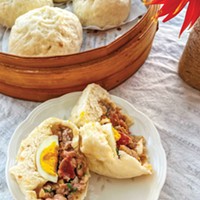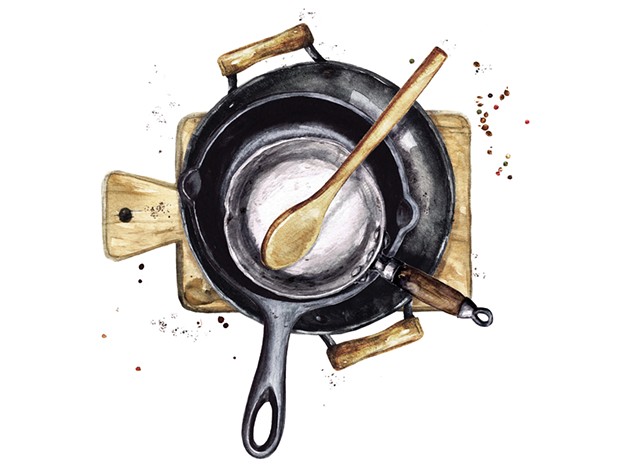[
{
"name": "Top Stories Video Pair",
"insertPoint": "7",
"component": "17087298",
"parentWrapperClass": "fdn-ads-inline-content-block",
"requiredCountToDisplay": "1"
}
]
I made too much Japanese curry last weekend. I chopped the onions, carrots, mushrooms and potatoes while talking on the phone with a friend who is struggling with whether to fly across the country to visit her ailing father. She was calculating the risk of traveling, how she'd manage quarantining before going near her parents, then all of it in reverse on the way back. She was figuring the abstract weight of guilt if he should die against the possibility of illness and more death should she contract and pass COVID-19.
I listened and kept chopping, the pile of cut vegetables doubling and re-doubling again. After we said goodbye, I looked at the mound spilling from the cutting board and knew I'd stress-chopped my way to a pot of curry better suited to a mess hall than a family.
Curry is the dish my family requests most from me. Winter or summer, ladled over bowls of white rice, it's our comfort food. Despite never having met him, my husband eats it the same way as my grandfather: with a pleased grunt and a handful of grated cheese. That in itself is usually a balm to me.
But lately, comfort may be too much to ask of a meal. Would my nerves settle if I pulled the leftover rice from the fridge and cooked it into soupy okayu? If I finally made the doughy tempura my grandparents preferred, would it tether me against the current of anxiety?
Amid an explosion of food insecurity in our county, I'm lucky to be able to feed my family, much less expect it to make me feel better. It's just that it normally does. We seek comfort in the pleasure and nostalgia of foods that recall love and nurturing, but those foods comfort the maker, too. What better way to ease worry over a sick loved one than to make soup? To feel of use, not helpless, and to lose oneself in the ritual and physical work of cooking can be a respite from the overwhelm of, well, everything. Even when I am cussing over a dumpling skin sticking to the pan, I'm only pissed about the torn wrapper and the little ball of meat tumbling out, not the larger world. But lately that narrow focus has been harder to come by.
Since the pandemic reached the U.S., our food media and restaurant takeout menus have leaned into the heavy, homey food we seek solace in, even as the upheaval threatens their financial and literal survival. It's strange to pick up a dinner that says, "It's going to be OK" from a restaurant worker who doesn't necessarily know or believe that. But then, so much of the comfort food we know is born of poverty — cheap ingredients (at least at one time) made into filling meals by people who weren't sure there would be a next one. There's something hopeful and defiant in those meals, and in experiencing pleasure even in hard times.
Where I grew up, after a funeral there was always food and a cluster of bottles "back at the house" — stacks of sandwiches and a ham for the Irish, a lasagna, baked ziti and platters of powdery cookies from the bakery if it was Italian. You cooked and brought food to the crowded table, moved through the rooms with a little plate that gave your hands and mouth something to do if you weren't shuttling silverware or fetching ice. But now, even the ritual of shuffling around a spread of cold meats with relatives is dangerous. A dear friend's father died and I didn't bring her so much as a pan of muffins. She and her partner were already inundated and, isolated at home without a gathering, who would eat it all?
Some 200,000 Americans have died of COVID-19 related illness. We've had no national mourning as we do annually for victims of 9/11 and our grief — for strangers, those we know, people we love — drifts over us like the wildfire smoke, changing the air, the taste of everything. Perhaps it's easier to mourn 9/11 victims and Justice Ruth Bader Ginsburg because their deaths were finite, unlike COVID-19's seemingly endless tide of obituaries. Or maybe it's harder to grieve and find catharsis when we know so many could have been saved if we'd immediately committed to lockdowns, masking and social distancing. Maybe what we really need is to atone.
Not that I am optimistic about a true atonement. After a spring and summer of Black Lives Matter protests and the whiplash between energizing moments and violence, word that the Louisville, Kentucky, police who shot Breonna Taylor would not face charges felt like a final, damning answer from our justice system. Every awful piece of news that followed seemed like piling on, embellishments on a foundational wrong, one upon which nothing good can be built. What comfort is there for this?
Once in my 20s, after a heartbreak I wish I'd recognized as the minor calamity it was, my mother hauled me, red-eyed and limp, to a Chinese place around the corner from her apartment for crab egg drop soup. She nagged me into spoonful after spoonful until I could finally taste it, warning me that what lay ahead — fetching my things, figuring out where I was going to live, finishing school — would be hard whether I was weak or strong so I'd better eat. So I ate.
And so we cook. Like we do everything else, even if it doesn't bring us joy yet. We keep taking spoonfuls until we can taste it. The same way we protest without expecting things will change immediately or call an elected official without expecting them to pick up, or send whatever donation we can manage even when it feels like flicking a coin into the sea. We cook what our ancestors cooked. We feed ourselves and the people who can safely get in 6 feet of us because we're alive and there is still joy to be had. We make too much and drop some off for someone else if we can. And we accept what's given to us, taking comfort in it being given at all in the middle of all this. Because what is coming will be hard whether we're weak or strong.
Speaking of...
-

Grandpa's Gifts
Nov 2, 2023 -

California Needs Thousands of Nurses, but Leaders Can’t Agree on How to Fill Jobs
Jul 31, 2023 -

Helping Homeowners: California Expands Mortgage Relief
Feb 7, 2023 - More »
Comments
Showing 1-1 of 1
more from the author
-
Eco Cemeteries, Flags, Impacts and Foods
- Apr 12, 2024
-
Sunken Seaweed's Dual Mission
Stocking shelves and the ocean with seaweed and kelp
- Apr 11, 2024
-
Alternative Energy Brainstorming with Billionaires
- Apr 11, 2024
- More »

































